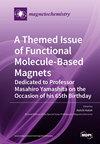纳米和多晶块体蓝晶石La0.7Ba(0.3−x)CaxMnO3(x≤0.25)的磁热性能
IF 2.6
4区 化学
Q2 CHEMISTRY, INORGANIC & NUCLEAR
引用次数: 0
摘要
在这里,我们报道了大块和纳米尺寸的La0.7Ba0.3−xCaxMnO3(x=0、0.15、0.2和0.25)化合物的合成和研究,这些化合物是磁制冷应用的有前途的候选者。我们比较了体相和纳米级多晶La0.7Ba0.3−xCaxMnO3在磁冷却系统中的潜在用途的结构和磁性能。固态反应用于大块材料,而溶胶-凝胶法用于纳米颗粒。通过X射线衍射(XRD)、光学显微镜和透射电子显微镜(TEM)对样品的结构和形态进行了研究。用碘量法研究了氧的化学计量。大块化合物表现出缺氧,而纳米颗粒表现出过量的氧气。使用改进的Arrott图(MAP)方法揭示了所有样品的临界磁行为,并通过Kouvel–Fisher(KF)方法进行了确认。体相多晶化合物的行为由三临界场模型更好地描述,而纳米晶体样品由平均场模型控制。块体材料中的电阻率在归因于晶界条件的温度Tp1和与居里温度Tc相关的温度Tp2处显示出峰值。母体多晶样品La0.7Ba0.3MnO3在340K处具有Tc。Ca的x=0.15的替代使Tc达到308K,x=0.2使其达到279K。纳米晶体样品在磁热效应中表现出非常宽的有效温度范围,高达100K。块状化合物在磁熵变化中表现出高而尖锐的峰值,当x=0.25时,在Tc为4T时高达7J/kgK。为了比较所研究化合物的磁热性能,使用了相对冷却功率(RCP)和温度平均熵变(TEC)的优值。RCP对于相同取代水平的大块多晶和纳米尺寸的样品是可比较的,而TEC在这两个系统之间显示出很大的差异。大块材料和纳米晶体材料的结合有助于磁热材料的有效性和改进。本文章由计算机程序翻译,如有差异,请以英文原文为准。
Magnetic and Magnetocaloric Properties of Nano- and Polycrystalline Bulk Manganites La0.7Ba(0.3−x)CaxMnO3 (x ≤ 0.25)
Here we report the synthesis and investigation of bulk and nano-sized La0.7Ba0.3−xCaxMnO3 (x = 0, 0.15, 0.2 and 0.25) compounds that are promising candidates for magnetic refrigeration applications. We compare the structural and magnetic properties of bulk and nano-scale polycrystalline La0.7Ba0.3−xCaxMnO3 for potential use in magnetic cooling systems. Solid-state reactions were implemented for bulk materials, while the sol–gel method was used for nano-sized particles. Structurally and morphologically, the samples were investigated by X-ray diffraction (XRD), optical microscopy and transmission electron microscopy (TEM). Oxygen stoichiometry was investigated by iodometry. Bulk compounds exhibit oxygen deficiency, while nano-sized particles show excess oxygen. Critical magnetic behavior was revealed for all samples using the modified Arrott plot (MAP) method and confirmed by the Kouvel–Fisher (KF) method. The bulk polycrystalline compound behavior was better described by the tricritical field model, while the nanocrystalline samples were governed by the mean-field model. Resistivity in bulk material showed a peak at a temperature Tp1 attributed to grain boundary conditions and at Tp2 associated with a Curie temperature of Tc. Parent polycrystalline sample La0.7Ba0.3MnO3 has Tc at 340 K. Substitution of x = 0.15 of Ca brings Tc to 308 K, and x = 0.2 brings it to 279 K. Nanocrystalline samples exhibit a very wide effective temperature range in the magnetocaloric effect, up to 100 K. Bulk compounds exhibit a high and sharp peak in magnetic entropy change, up to 7 J/kgK at 4 T at Tc for x = 0.25. To compare the magnetocaloric performances of the studied compounds, both relative cooling power (RCP) and temperature-averaged entropy change (TEC) figures of merit were used. RCP is comparable for bulk polycrystalline and nano-sized samples of the same substitution level, while TEC shows a large difference between the two systems. The combination of bulk and nanocrystalline materials can contribute to the effectiveness and improvement of magnetocaloric materials.
求助全文
通过发布文献求助,成功后即可免费获取论文全文。
去求助
来源期刊

Magnetochemistry
Chemistry-Chemistry (miscellaneous)
CiteScore
3.90
自引率
11.10%
发文量
145
审稿时长
11 weeks
期刊介绍:
Magnetochemistry (ISSN 2312-7481) is a unique international, scientific open access journal on molecular magnetism, the relationship between chemical structure and magnetism and magnetic materials. Magnetochemistry publishes research articles, short communications and reviews. Our aim is to encourage scientists to publish their experimental and theoretical results in as much detail as possible. Therefore, there is no restriction on the length of the papers. The full experimental details must be provided so that the results can be reproduced.
 求助内容:
求助内容: 应助结果提醒方式:
应助结果提醒方式:


